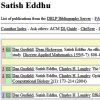| |
 
Vineet Bafna and
Vikas Bansal. The Number of Recombination Events in a Sample History: Conflict Graph and Lower Bounds. In TCBB, Vol. 1(2):78-90, 2004.
Keywords: ARG, bound, minimum number, phylogeny, recombination.
Note: http://www-cse.ucsd.edu/users/vbafna/pub/tcbb04.pdf.
Toggle abstract
"We consider the following problem: Given a set of binary sequences, determine lower bounds on the minimum number of recombinations required to explain the history of the sample, under the infinite-sites model of mutation. The problem has implications for finding recombination hotspots and for the Ancestral Recombination Graph reconstruction problem. Hudson and Kaplan gave a lower bound based on the four-gamete test. In practice, their bound R m often greatly underestimates the minimum number of recombinations. The problem was recently revisited by Myers and Griffiths, who introduced two new lower bounds R h and R s which are provably better, and also yield good bounds in practice. However, the worst-case complexities of their procedures for computing R h and R s are exponential and super-exponential, respectively. In this paper, we show that the number of nontrivial connected components, Rc, in the conflict graph for a given set of sequences, computable in time O(nm 2), is also a lower bound on the minimum number of recombination events. We show that in many cases, R c is a better bound than R h. The conflict graph was used by Gusfield et al. to obtain a polynomial time algorithm for the galled tree problem, which is a special case of the Ancestral Recombination Graph (ARG) reconstruction problem. Our results also offer some insight into the structural properties of this graph and are of interest for the general Ancestral Recombination Graph reconstruction problem."
|
|
| |
  
Dan Gusfield,
Satish Eddhu and
Charles Langley. Optimal, Efficient Reconstruction of Phylogenetic Networks with Constrained Recombination. In JBCB, Vol. 2(1):173-213, 2004.
Keywords: explicit network, from sequences, galled tree, phylogenetic network, phylogeny, recombination, reconstruction.
Note: http://wwwcsif.cs.ucdavis.edu/~gusfield/exfinalrec.pdf.
Toggle abstract
"A phylogenetic network is a generalization of a phylogenetic tree, allowing structural properties that are not tree-like. In a seminal paper, Wang et al.1 studied the problem of constructing a phylogenetic network, allowing recombination between sequences, with the constraint that the resulting cycles must be disjoint. We call such a phylogenetic network a "galled-tree". They gave a polynomial-time algorithm that was intended to determine whether or not a set of sequences could be generated on galled-tree. Unfortunately, the algorithm by Wang et al.1 is incomplete and does not constitute a necessary test for the existence of a galled-tree for the data. In this paper, we completely solve the problem. Moreover, we prove that if there is a galled-tree, then the one produced by our algorithm minimizes the number of recombinations over all phylogenetic networks for the data, even allowing multiple-crossover recombinations. We also prove that when there is a galled-tree for the data, the galled-tree minimizing the number of recombinations is "essentially unique" . We. also note two additional results: first, any set of sequences that can be derived on a galled tree can be derived on a true tree (without recombination cycles), where at most one back mutation per site is allowed; second, the site compatibility problem (which is NP-hard in general) can be solved in polynomial time for any set of sequences that can be derived on a galled tree. Perhaps more important than the specific results about galled-trees, we introduce an approach that can be used to study recombination in general phylogenetic networks. This paper greatly extends the conference version that appears in an earlier work.8 PowerPoint slides of the conference talk can be found at our website. © Imperial College Press."
|
|
| |

Jotun Hein. A heuristic method to reconstruct the history of sequences subject to recombination. In JME, Vol. 36(4):396-405, 1993.
Keywords: explicit network, from sequences, heuristic, parsimony, phylogenetic network, phylogeny, Program RecPars, recombination, recombination detection, software.
Note: http://dx.doi.org/10.1007/BF00182187.
|
|
| |
|
| |
  
David Posada,
Keith A. Crandall and
Edward C. Holmes. Recombination in Evolutionary Genomics. In ARG, Vol. 36:75-97, 2002.
Keywords: phylogenetic network, phylogeny, recombination, recombination detection, survey.
Note: http://dx.doi.org/10.1146/annurev.genet.36.040202.111115.
Toggle abstract
"Recombination can be a dominant force in shaping genomes and associated phenotypes. To better understand the impact of recombination on genomic evolution, we need to be able to identify recombination in aligned sequences. We review bioinformatic approaches for detecting recombination and measuring recombination rates. We also examine the impact of recombination on the reconstruction of evolutionary histories and the estimation of population genetic parameters. Finally, we review the role of recombination in the evolutionary history of bacteria, viruses, and human mitochondria. We conclude by highlighting a number of areas for future development of tools to help quantify the role of recombination in genomic evolution."
|
|
| |
 
Yun S. Song and
Jotun Hein. On the Minimum Number of Recombination Events in the Evolutionary History of DNA Sequences. In JOMB, Vol. 48(2):160-186, 2004.
Keywords: minimum number, recombination.
Note: http://dx.doi.org/10.1007/s00285-003-0227-5.
Toggle abstract
"In representing the evolutionary history of a set of binary DNA sequences by a connected graph, a set theoretical approach is introduced for studying recombination events. We show that set theoretical constraints have direct implications on the number of recombination events. We define a new lower bound on the number of recombination events and demonstrate the usefulness of our new approach through several explicit examples. © Springer-Verlag 2003."
|
|
| |
|
| |
|
| |
  
Alan R. Templeton,
Keith A. Crandall and
Charles F. Sing. A Cladistic Analysis of Phenotypic Associations With Haplotypes Inferred From Restriction Endonuclease Mapping and DNA Sequence Data. III. Cladogram Estimation. In GEN, Vol. 132:619-633, 2000.
Keywords: from sequences, parsimony, phylogenetic network, phylogeny, Program TCS, recombination, reconstruction, statistical parsimony.
Note: http://www.genetics.org/cgi/content/abstract/132/2/619.
|
|
| |
   
Dan Gusfield,
Vikas Bansal,
Vineet Bafna and
Yun S. Song. A Decomposition Theory for Phylogenetic Networks and Incompatible Characters. In JCB, Vol. 14(10):1247-1272, 2007.
Keywords: explicit network, from sequences, galled tree, phylogenetic network, phylogeny, Program Beagle, Program GalledTree, recombination, reconstruction, software.
Note: http://www.eecs.berkeley.edu/~yss/Pub/decomposition.pdf.
|
|
| |
 
Patricia Buendia and
Giri Narasimhan. Serial NetEvolve: A flexible utility for generating serially-sampled sequences along a tree or recombinant network. In BIO, Vol. 18(22):2313-2314, 2006.
Keywords: generation, phylogenetic network, phylogeny, Program Serial NetEvolve, Program Treevolve, recombination, software.
Note: http://dx.doi.org/10.1093/bioinformatics/btl387.
Toggle abstract
"Summary: Serial NetEvolve is a flexible simulation program that generates DNA sequences evolved along a tree or recombinant network. It offers a user-friendly Windows graphical interface and a Windows or Linux simulator with a diverse selection of parameters to control the evolutionary model. Serial NetEvolve is a modification of the Treevolve program with the following additional features: simulation of serially-sampled data, the choice of either a clock-like or a variable rate model of sequence evolution, sampling from the internal nodes and the output of the randomly generated tree or network in our newly proposed NeTwick format. © 2006 Oxford University Press."
|
|
| |
 
Patricia Buendia and
Giri Narasimhan. Sliding MinPD: Building evolutionary networks of serial samples via an automated recombination detection approach. In BIO, Vol. 23(22):2993-3000, 2007.
Keywords: from sequences, phylogenetic network, phylogeny, Program Sliding MinPD, recombination, recombination detection, serial evolutionary networks, software.
Note: http://dx.doi.org/10.1093/bioinformatics/btm413.
Toggle abstract
"Motivation: Traditional phylogenetic methods assume tree-like evolutionary models and are likely to perform poorly when provided with sequence data from fast-evolving, recombining viruses. Furthermore, these methods assume that all the sequence data are from contemporaneous taxa, which is not valid for serially-sampled data. A more general approach is proposed here, referred to as the Sliding MinPD method, that reconstructs evolutionary networks for serially-sampled sequences in the presence of recombination. Results: Sliding MinPD combines distance-based phylogenetic methods with automated recombination detection based on the best-known sliding window approaches to reconstruct serial evolutionary networks. Its performance was evaluated through comprehensive simulation studies and was also applied to a set of serially-sampled HIV sequences from a single patient. The resulting network organizations reveal unique patterns of viral evolution and may help explain the emergence of disease-associated mutants and drug-resistant strains with implications for patient prognosis and treatment strategies. © The Author 2007. Published by Oxford University Press. All rights reserved."
|
|
| |
    
Joanna L. Davies,
Frantisek Simancík,
Rune Lyngsø,
Thomas Mailund and
Jotun Hein. On Recombination-Induced Multiple and Simultaneous Coalescent Events. In GEN, Vol. 177:2151-2160, 2007.
Keywords: coalescent, phylogenetic network, phylogeny, recombination, statistical model.
Note: http://dx.doi.org/10.1534/genetics.107.071126.
Toggle abstract
"Coalescent theory deals with the dynamics of how sampled genetic material has spread through a population from a single ancestor over many generations and is ubiquitous in contemporary molecular population genetics. Inherent in most applications is a continuous-time approximation that is derived under the assumption that sample size is small relative to the actual population size. In effect, this precludes multiple and simultaneous coalescent events that take place in the history of large samples. If sequences do not recombine, the number of sequences ancestral to a large sample is reduced sufficiently after relatively few generations such that use of the continuous-time approximation is justified. However, in tracing the history of large chromosomal segments, a large recombination rate per generation will consistently maintain a large number of ancestors. This can create a major disparity between discrete-time and continuous-time models and we analyze its importance, illustrated with model parameters typical of the human genome. The presence of gene conversion exacerbates the disparity and could seriously undermine applications of coalescent theory to complete genomes. However, we show that multiple and simultaneous coalescent events influence global quantities, such as total number of ancestors, but have negligible effect on local quantities, such as linkage disequilibrium. Reassuringly, most applications of the coalescent model with recombination (including association mapping) focus on local quantities. Copyright © 2007 by the Genetics Society of America."
|
|
| |
  
Bin Ma,
Lusheng Wang and
Ming Li. Fixed topology alignment with recombination. In DAM, Vol. 104:281-300, 2000.
Keywords: approximation, explicit network, from network, from sequences, galled tree, inapproximability, phylogenetic network, phylogeny, recombination.
Note: http://citeseerx.ist.psu.edu/viewdoc/summary?doi=10.1.1.40.7759.
Toggle abstract
"Background: Reticulate events play an important role in determining evolutionary relationships. The problem of computing the minimum number of such events to explain discordance between two phylogenetic trees is a hard computational problem. Even for binary trees, exact solvers struggle to solve instances with reticulation number larger than 40-50.Results: Here we present CycleKiller and NonbinaryCycleKiller, the first methods to produce solutions verifiably close to optimality for instances with hundreds or even thousands of reticulations.Conclusions: Using simulations, we demonstrate that these algorithms run quickly for large and difficult instances, producing solutions that are very close to optimality. As a spin-off from our simulations we also present TerminusEst, which is the fastest exact method currently available that can handle nonbinary trees: this is used to measure the accuracy of the NonbinaryCycleKiller algorithm. All three methods are based on extensions of previous theoretical work (SIDMA 26(4):1635-1656, TCBB 10(1):18-25, SIDMA 28(1):49-66) and are publicly available. We also apply our methods to real data. © 2014 van Iersel et al.; licensee BioMed Central Ltd."
|
|
| |

David A. Morrison. Using data-display networks for exploratory data analysis in phylogenetic studies. In MBE, Vol. 27(5):1044-1057, 2010.
Keywords: abstract network, hybridization, NeighborNet, Program SplitsTree, recombination, split decomposition.
Note: http://dx.doi.org/10.1093/molbev/msp309.
Toggle abstract
"Exploratory data analysis (EDA) is a frequently undervalued part of data analysis in biology. It involves evaluating the characteristics of the data "before" proceeding to the definitive analysis in relation to the scientific question at hand. For phylogenetic analyses, a useful tool for EDA is a data-display network. This type of network is designed to display any character (or tree) conflict in a data set, without prior assumptions about the causes of those conflicts. The conflicts might be caused by 1) methodological issues in data collection or analysis, 2) homoplasy, or 3) horizontal gene flow of some sort. Here, I explore 13 published data sets using splits networks, as examples of using data-display networks for EDA. In each case, I performed an original EDA on the data provided, to highlight the aspects of the resulting network that will be important for an interpretation of the phylogeny. In each case, there is at least one important point (possibly missed by the original authors) that might affect the phylogenetic analysis. I conclude that EDA should play a greater role in phylogenetic analyses than it has done. © 2010 The Author. Published by Oxford University Press on behalf of the Society for Molecular Biology and Evolution. All rights reserved."
|
|
|
|
| |
|
| |
|
| |
|
| |
 
Daniel H. Huson and
Tobias Kloepper. Computing recombination networks from binary sequences. In ECCB05, Vol. 21(suppl. 2):ii159-ii165 of BIO, 2005.
Keywords: from sequences, phylogenetic network, phylogeny, recombination.
Note: http://dx.doi.org/10.1093/bioinformatics/bti1126.
Toggle abstract
"Motivation:Phylogenetic networks are becoming an important tool in molecular evolution, as the evolutionary role of reticulate events, such as hybridization, horizontal gene transfer and recombination, is becoming more evident, and as the available data is dramatically increasing in quantity and quality. Results: This paper addresses the problem of computing a most parsimonious recombination network for an alignment of binary sequences that are assumed to have arisen under the 'infinite sites' model of evolution with recombinations. Using the concept of a splits network as the underlying datastructure, this paper shows how a recent method designed for the computation of hybridization networks can be extended to also compute recombination networks. A robust implementation of the approach is provided and is illustrated using a number of real biological datasets. © The Author 2005. Published by Oxford University Press. All rights reserved."
|
|
| |
|
| |
  
Rune Lyngsø,
Yun S. Song and
Jotun Hein. Minimum Recombination Histories by Branch and Bound. In WABI05, Vol. 3692:239-250 of LNCS, springer, 2005.
Keywords: ARG, branch and bound, from sequences, minimum number, Program Beagle, recombination, reconstruction, software.
Note: http://www.cs.ucdavis.edu/~yssong/Pub/WABI05-239.pdf.
|
|
| |
|
| |
  
Yun S. Song,
Yufeng Wu and
Dan Gusfield. Efficient computation of close lower and upper bounds on the minimum number of recombinations in biological sequence evolution. In ISMB05, Vol. 21:i413-i422 of BIO, 2005.
Keywords: integer linear programming, minimum number, Program HapBound, Program SHRUB, recombination.
Note: http://dx.doi.org/10.1093/bioinformatics/bti1033.
Toggle abstract
"Motivation: We are interested in studying the evolution of DNA single nucleotide polymorphism sequences which have undergone (meiotic) recombination. For a given set of sequences, computing the minimum number of recombinations needed to explain the sequences (with one mutation per site) is a standard question of interest, but it has been shown to be NP-hard, and previous algorithms that compute it exactly work either only on very small datasets or on problems with special structure. Results: In this paper, we present efficient, practical methods for computing both upper and lower bounds on the minimum number of needed recombinations, and for constructing evolutionary histories that explain the input sequences. We study in detail the efficiency and accuracy of these algorithms on both simulated and real data sets. The algorithms produce very close upper and lower bounds, which match exactly in a surprisingly wide range of data. Thus, with the use of new, very effective lower bounding methods and an efficient algorithm for computing upper bounds, this approach allows the efficient, exact computation of the minimum number of needed recombinations, with high frequency in a large range of data. When upper and lower bounds match, evolutionary histories found by our algorithm correspond to the most parsimonious histories. © The Author 2005. Published by Oxford University Press. All rights reserved."
|
|
| |
  
Lusheng Wang,
Kaizhong Zhang and
Louxin Zhang. Perfect phylogenetic networks with recombination. In SAC01, Pages 46-50, 2001.
Keywords: from sequences, galled tree, NP complete, perfect, phylogenetic network, phylogeny, polynomial, recombination, reconstruction.
Note: http://dx.doi.org/10.1145/372202.372271.
|
|
| |
  
Rune Lyngsø,
Yun S. Song and
Jotun Hein. Accurate Computation of Likelihoods in the Coalescent with Recombination via Parsimony. In RECOMB08, Vol. 4955:463-477 of LNCS, springer, 2008.
Keywords: coalescent, likelihood, phylogenetic network, phylogeny, recombination, statistical model.
Note: http://dx.doi.org/10.1007/978-3-540-78839-3_41.
Toggle abstract
"Understanding the variation of recombination rates across a given genome is crucial for disease gene mapping and for detecting signatures of selection, to name just a couple of applications. A widely-used method of estimating recombination rates is the maximum likelihood approach, and the problem of accurately computing likelihoods in the coalescent with recombination has received much attention in the past. A variety of sampling and approximation methods have been proposed, but no single method seems to perform consistently better than the rest, and there still is great value in developing better statistical methods for accurately computing likelihoods. So far, with the exception of some two-locus models, it has remained unknown how the true likelihood exactly behaves as a function of model parameters, or how close estimated likelihoods are to the true likelihood. In this paper, we develop a deterministic, parsimony-based method of accurately computing the likelihood for multi-locus input data of moderate size. We first find the set of all ancestral configurations (ACs) that occur in evolutionary histories with at most k crossover recombinations. Then, we compute the likelihood by summing over all evolutionary histories that can be constructed only using the ACs in that set. We allow for an arbitrary number of crossing over, coalescent and mutation events in a history, as long as the transitions stay within that restricted set of ACs. For given parameter values, by gradually increasing the bound k until the likelihood stabilizes, we can obtain an accurate estimate of the likelihood. At least for moderate crossover rates, the algorithm-based method described here opens up a new window of opportunities for testing and fine-tuning statistical methods for computing likelihoods. © 2008 Springer-Verlag Berlin Heidelberg."
|
|
| |
|
| |
  
Bin Ma,
Lusheng Wang and
Ming Li. Fixed topology alignment with recombination. In CPM98, Vol. 1448:174-188 of LNCS, springer, 1998.
Keywords: approximation, explicit network, from network, from sequences, galled tree, inapproximability, phylogenetic network, phylogeny, recombination.
Note: http://dx.doi.org/10.1007/BFb0030789.
|
|
|
|
 - forked on GitHub.
- forked on GitHub.






























